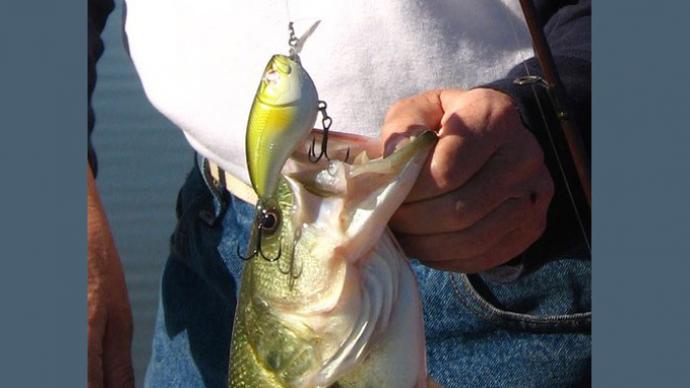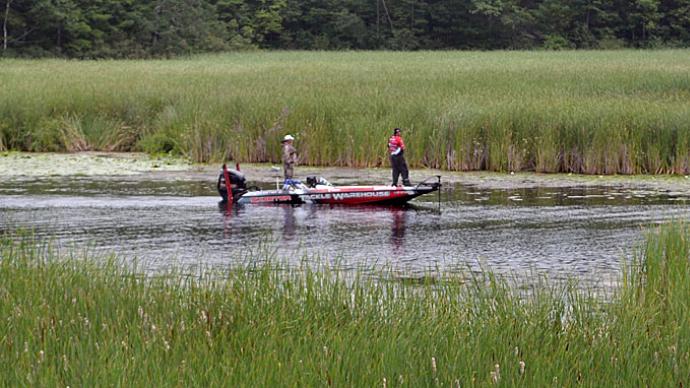SAVANNAH, Ga. --- Largemouth Bass Virus (LMBV) presents a multifaceted resource problem, according to state and federal fisheries biologists and government and university research scientists who gathered here February 3 to share information and plan strategies for monitoring and further investigation. But, they added emphatically, the recently discovered virus does not appear to pose the dire threat to bass and bass fishing that some anglers fear.
"LMBV is just another variable in the ecology of the fish. Bass will adapt to it," said Dr. Larry Hanson, representing the College of Veterinary Medicine at Mississippi State University. Hanson was one of more than 70 attendees who attended the all-day session organized and sponsored by B.A.S.S., Inc. The workshop represented the first attempt to gain a national perspective on the virus that first was linked to a fish kill in 1995, on Santee-Cooper Reservoir in South Carolina.
Since then, the virus has caused at least 11 more fish kills on reservoirs from Texas to South Carolina and Georgia, with most of the kills occurring during 1998 and 1999. In proportion to the overall bass populations at the lakes where they happened, the fish kills have been relatively minor, agency biologists said. Still, the die-offs were big enough to gain the attention of anglers, especially since almost all of the fatalities were large adult bass. So, along with investigating the virus itself and the impact on the bass populations of the affected lakes, state agencies have had to work hard to allay fears, especially in states such as Mississippi and Texas, where the most kills have occurred.
Anglers in Mississippi are "very worried about this and their concern is growing," said fisheries biologists from that state. In nearby Louisiana, reaction ranges from "over-reactive to inquisitive." In South Carolina, though, "the virus is overshadowed by aquatic plant management issues."
"Fishermen in Texas do know about the virus," said Phil Durocher, Texas fisheries chief. "We want to look at the long-term impacts it might have on fishing. We know that fishing can be poor for a little while after a kill, but then it picks up. "We plan to do a survey to determine the distribution of the virus. We're concerned about the environmental factors that might contribute to it. So far, we've found the virus everywhere we've looked (five reservoirs)."
Finding bass carrying the virus, though, is not the same as finding sick or diseased bass. Following recognition of LMBV as a unique virus and a contributor to isolated fish kills, researchers began to examine "healthy" fish from major reservoirs across the Southeast. During 1997-1998, they sampled fish in 75 impoundments in eight states, finding LMBV at six of those places.
"A few days ago, the virus was isolated in smallmouth bass and spotted bass at Kentucky Lake," Kentucky biologists reported. "But there have been no kills that we know of."
The big mystery, workshop attendees agreed, is what triggers the virus to suddenly turn into a deadly disease. Thus far, the only common denominator seems to be warm weather, as all of the kills have occurred from June through September.
"Stress might pre-dispose the fish to disease," said Dr. John Grizzle of Auburn University. That stress could come in the form of poor water quality from high temperatures and pollution or from frequent catch and release by anglers.
Also, the research pathologists do not know how the virus is spread from one fish to another and from one fishery to another. One theory is that anglers could unknowingly transport the virus in their livewells or bilges. Consequently, state agencies recommend that anglers drain and clean their boats thoroughly between fishing trips.
They definitely advise against moving bass from one lake to another and releasing live bait, since other fish, and possibly even amphibians, could be carriers of LMBV.
"Amphibians, reptiles, or other fish species can be carriers in viruses like this," said Dr. Grizzle. "There are at least two viruses that affect both fish and amphibians."
Yet another uncertainty is how old LMBV is. Some at the workshop think is it a new virus. Others believe that is has been around awhile, even though it was only recently recognized. "I think that it is too broadly spread to be recent," said Dr. John Plumb of Auburn. "More people are looking for viruses today. We've found more than 100 different viruses in fish, but largemouth bass have not been looked at critically for viral agents until recently. I think LMBV has been there, maybe in a dormant stage, and now conditions are right for it to occur."
Whatever its reasons for manifesting in bass right now, LMBV poses no threat to humans. Infected fish can be safely handled and eaten, scientists said. They added, though, that common sense dictates that fish that are dead or dying, no matter what the reason, should not be used for human food.
For more information on LMBV, contact the fisheries office of your state Conservation Department. Call the B.A.S.S. Conservation Department at (334)272-9530 or write via e-mail to conservation@bassmaster.com if you need your state agency contact information.



